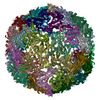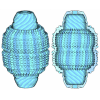+ データを開く
データを開く
- 基本情報
基本情報
| 登録情報 | データベース: PDB / ID: 9fn9 | ||||||
|---|---|---|---|---|---|---|---|
| タイトル | Icosahedral Encapsulin with a closed pore state | ||||||
 要素 要素 | 29 kDa antigen Cfp29 | ||||||
 キーワード キーワード | BIOSYNTHETIC PROTEIN / Nanocompartment | ||||||
| 機能・相同性 | Type 1 encapsulin shell protein / Encapsulating protein for peroxidase / : / encapsulin nanocompartment / Type 1 encapsulin shell protein 機能・相同性情報 機能・相同性情報 | ||||||
| 生物種 |  Mycolicibacterium smegmatis MC2 155 (バクテリア) Mycolicibacterium smegmatis MC2 155 (バクテリア) | ||||||
| 手法 | 電子顕微鏡法 / 単粒子再構成法 / クライオ電子顕微鏡法 / 解像度: 2.81 Å | ||||||
 データ登録者 データ登録者 | Capper, M.J. / Kohhnke, J. | ||||||
| 資金援助 | European Union, 1件
| ||||||
 引用 引用 |  ジャーナル: RSC Chem Biol / 年: 2024 ジャーナル: RSC Chem Biol / 年: 2024タイトル: A nanoengineered tandem nitroreductase: designing a robust prodrug-activating nanoreactor. 著者: Mariia Zmyslia / Michael J Capper / Michael Grimmeisen / Kerstin Sartory / Benedikt Deuringer / Mohamed Abdelsalam / Kaiwei Shen / Manfred Jung / Wolfgang Sippl / Hans-Georg Koch / Laurine ...著者: Mariia Zmyslia / Michael J Capper / Michael Grimmeisen / Kerstin Sartory / Benedikt Deuringer / Mohamed Abdelsalam / Kaiwei Shen / Manfred Jung / Wolfgang Sippl / Hans-Georg Koch / Laurine Kaul / Regine Süss / Jesko Köhnke / Claudia Jessen-Trefzer /    要旨: Nitroreductases are important enzymes for a variety of applications, including cancer therapy and bioremediation. They often require encapsulation to improve stability and activity. We focus on ...Nitroreductases are important enzymes for a variety of applications, including cancer therapy and bioremediation. They often require encapsulation to improve stability and activity. We focus on genetically encoded encapsulation of nitroreductases within protein capsids, like encapsulins. Our study showcases the encapsulation of nitroreductase NfsB as functional dimers within encapsulins, which enhances protein activity and stability in diverse conditions. Mutations within the pore region are beneficial for activity of the encapsulated enzyme, potentially by increasing diffusion rates. Cryogenic electron microscopy reveals the overall architecture of the encapsulated dimeric NfsB within the nanoreactor environment and identifies multiple pore states in the shell. These findings highlight the potential of encapsulins as versatile tools for enhancing enzyme performance across various fields. | ||||||
| 履歴 |
|
- 構造の表示
構造の表示
| 構造ビューア | 分子:  Molmil Molmil Jmol/JSmol Jmol/JSmol |
|---|
- ダウンロードとリンク
ダウンロードとリンク
- ダウンロード
ダウンロード
| PDBx/mmCIF形式 |  9fn9.cif.gz 9fn9.cif.gz | 2.7 MB | 表示 |  PDBx/mmCIF形式 PDBx/mmCIF形式 |
|---|---|---|---|---|
| PDB形式 |  pdb9fn9.ent.gz pdb9fn9.ent.gz | 表示 |  PDB形式 PDB形式 | |
| PDBx/mmJSON形式 |  9fn9.json.gz 9fn9.json.gz | ツリー表示 |  PDBx/mmJSON形式 PDBx/mmJSON形式 | |
| その他 |  その他のダウンロード その他のダウンロード |
-検証レポート
| 文書・要旨 |  9fn9_validation.pdf.gz 9fn9_validation.pdf.gz | 2.3 MB | 表示 |  wwPDB検証レポート wwPDB検証レポート |
|---|---|---|---|---|
| 文書・詳細版 |  9fn9_full_validation.pdf.gz 9fn9_full_validation.pdf.gz | 2.4 MB | 表示 | |
| XML形式データ |  9fn9_validation.xml.gz 9fn9_validation.xml.gz | 345.9 KB | 表示 | |
| CIF形式データ |  9fn9_validation.cif.gz 9fn9_validation.cif.gz | 483.9 KB | 表示 | |
| アーカイブディレクトリ |  https://data.pdbj.org/pub/pdb/validation_reports/fn/9fn9 https://data.pdbj.org/pub/pdb/validation_reports/fn/9fn9 ftp://data.pdbj.org/pub/pdb/validation_reports/fn/9fn9 ftp://data.pdbj.org/pub/pdb/validation_reports/fn/9fn9 | HTTPS FTP |
-関連構造データ
| 関連構造データ |  50585MC  9fnaC M: このデータのモデリングに利用したマップデータ C: 同じ文献を引用 ( |
|---|---|
| 類似構造データ | 類似検索 - 機能・相同性  F&H 検索 F&H 検索 |
- リンク
リンク
- 集合体
集合体
| 登録構造単位 | 
|
|---|---|
| 1 |
|
- 要素
要素
| #1: タンパク質 | 分子量: 30045.578 Da / 分子数: 60 / 由来タイプ: 組換発現 由来: (組換発現)  Mycolicibacterium smegmatis MC2 155 (バクテリア) Mycolicibacterium smegmatis MC2 155 (バクテリア)遺伝子: MSMEG_5830 / 発現宿主:  Has protein modification | N | |
|---|
-実験情報
-実験
| 実験 | 手法: 電子顕微鏡法 |
|---|---|
| EM実験 | 試料の集合状態: PARTICLE / 3次元再構成法: 単粒子再構成法 |
- 試料調製
試料調製
| 構成要素 | 名称: Cryo-EM structure of encapsulin shell containing engineered tandem dimer NfsB タイプ: COMPLEX / Entity ID: all / 由来: RECOMBINANT | ||||||||||||
|---|---|---|---|---|---|---|---|---|---|---|---|---|---|
| 分子量 | 実験値: NO | ||||||||||||
| 由来(天然) | 生物種:  Mycolicibacterium smegmatis (バクテリア) Mycolicibacterium smegmatis (バクテリア) | ||||||||||||
| 由来(組換発現) | 生物種:  | ||||||||||||
| 緩衝液 | pH: 7.5 | ||||||||||||
| 緩衝液成分 |
| ||||||||||||
| 試料 | 濃度: 20 mg/ml / 包埋: NO / シャドウイング: NO / 染色: NO / 凍結: YES | ||||||||||||
| 試料支持 | グリッドの材料: COPPER / グリッドのサイズ: 300 divisions/in. / グリッドのタイプ: Quantifoil R1.2/1.3 | ||||||||||||
| 急速凍結 | 装置: FEI VITROBOT MARK IV / 凍結剤: ETHANE / 湿度: 95 % / 凍結前の試料温度: 281 K |
- 電子顕微鏡撮影
電子顕微鏡撮影
| 顕微鏡 | モデル: JEOL CRYO ARM 300 |
|---|---|
| 電子銃 | 電子線源:  FIELD EMISSION GUN / 加速電圧: 300 kV / 照射モード: FLOOD BEAM FIELD EMISSION GUN / 加速電圧: 300 kV / 照射モード: FLOOD BEAM |
| 電子レンズ | モード: BRIGHT FIELD / 倍率(公称値): 80000 X / 最大 デフォーカス(公称値): 1500 nm / 最小 デフォーカス(公称値): 500 nm / Cs: 2.7 mm / C2レンズ絞り径: 100 µm |
| 試料ホルダ | 凍結剤: NITROGEN / 試料ホルダーモデル: JEOL CRYOSPECPORTER |
| 撮影 | 平均露光時間: 1.5 sec. / 電子線照射量: 60.2 e/Å2 フィルム・検出器のモデル: DIRECT ELECTRON APOLLO (4k x 4k) 撮影したグリッド数: 1 |
| 電子光学装置 | エネルギーフィルター名称: In-column Omega Filter |
- 解析
解析
| EMソフトウェア | 名称: SerialEM / カテゴリ: 画像取得 |
|---|---|
| CTF補正 | タイプ: PHASE FLIPPING AND AMPLITUDE CORRECTION |
| 対称性 | 点対称性: C1 (非対称) |
| 3次元再構成 | 解像度: 2.81 Å / 解像度の算出法: FSC 0.143 CUT-OFF / 粒子像の数: 308711 / クラス平均像の数: 1 / 対称性のタイプ: POINT |
 ムービー
ムービー コントローラー
コントローラー




 PDBj
PDBj
